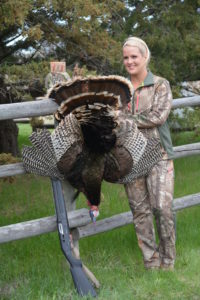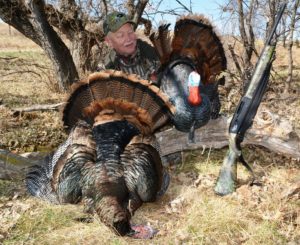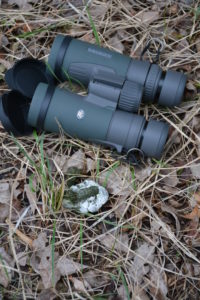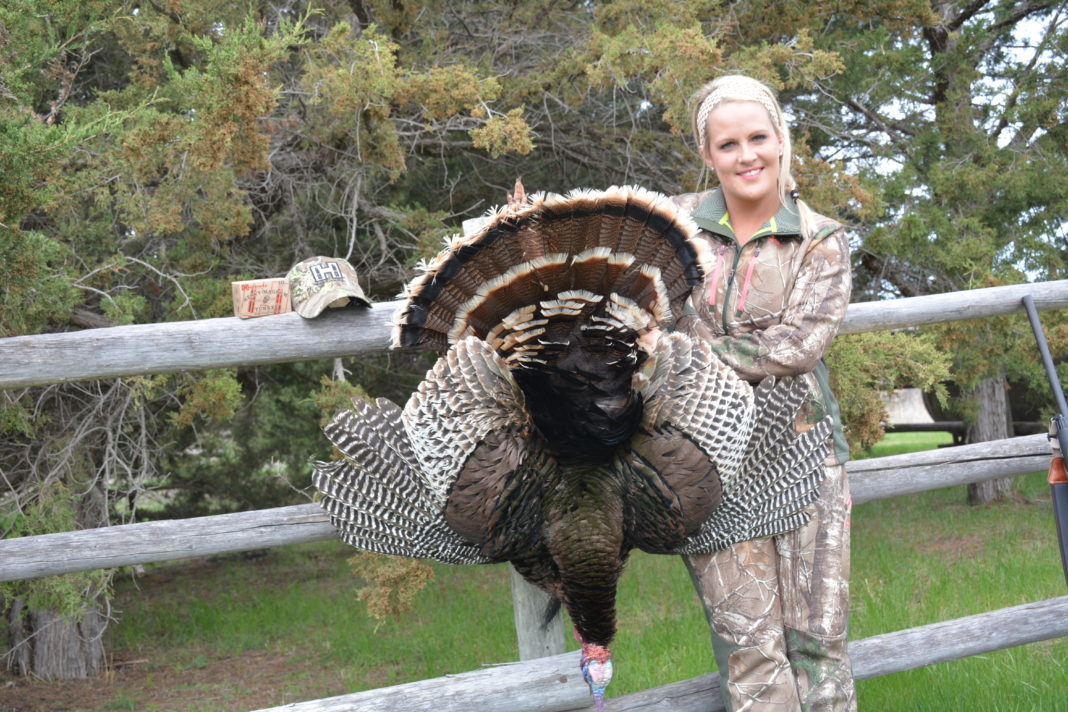A gobbler’s incredible vision is its greatest ally in the wide-open spaces of the Midwest and Great Plains, yet, by using a turkey fan or gobbler decoy, you can transform this nearly impenetrable defense into a kamikaze attack. When a gobbler sees an intruder (your decoy) it will often run right at the bird to protect its territory and establish dominance. Best of all, those older, most-dominant toms are the easiest to fool.
 Ken Byers and Emely Mierau teamed up on the last afternoon of her hunt. She had an empty tag and Byers knew of a remote ranch that received little hunting pressure. I tagged along since I also had an empty tag as well. As we passed a series of corrals, Byers spotted a gobbler and a hen feeding and instantly developed a plan.
Ken Byers and Emely Mierau teamed up on the last afternoon of her hunt. She had an empty tag and Byers knew of a remote ranch that received little hunting pressure. I tagged along since I also had an empty tag as well. As we passed a series of corrals, Byers spotted a gobbler and a hen feeding and instantly developed a plan.
After driving half a mile farther, he parked our new Nissan Titan and we made a large circle back toward the corrals. Stopping on a small knoll near the location, Byers yelped and got the gobbler’s attention. After posting the bogus tom on the horizon, both the hen and gobbler approached.
Great Video
Byers not only uses a Thunder Chicken and a real turkey feather fan but also adds a tiny video camera just below the tom’s head. Not only does this decoy draw in turkeys, but we get to relive the excitement back at camp. Apparently, the hen was anxious for company, as soft yelps from Byers’ diaphragm caller lured her straight to the gun. At 20 yards, Emily let loose a dose of Hornady turkey loads and the bird went right down.
Unbelievable Action

Half-way back to the truck, we were so anxious to see the video, that we stopped to view the action on a small tablet. Since we had seen only one gobbler, we weren’t concerned about sound level and reveled at the incredible action. Suddenly… incredibly… a gobbler sounded in the distance prompted by the calling on the tape. We looked at each other in disbelief and back tracked to locate the gobbler.
Apparently, a flock of turkeys roosted near those corrals and was headed steadily in our direction. This time Emily was the spectator and Byers and I belly crawled toward a large cottonwood for concealment. As the turkeys approached within 100 yards, Byers moved the decoy into the open and began calling. Immediately, three gobblers responded and separated from the flock.
Take Careful Aim
In typical gobbler-decoy fashion, the toms came directly toward the decoy fired up and ready to kick butt. Having seen this scenario many times before I knew I needed to be patient and make an exact shot.
At 30 yards, I could see all three heads down the barrel of my shotgun and believe that one shot would have taken them all. At 20 yards, one bird became suspicious and separated from the two strutting toms. I squeezed the trigger and our last-minute hunt turned into a double. Now we had two hunts on tape.
Safety Double Check

Using any type of decoy while hunting requires extra safety measures. The wide-open spaces of the Midwest are vastly different than the small properties and dense forests of the East where a hunter could sneak on your location and mistake the decoy for the real thing. If you see a truck or car parked in your hunting area, never use a gobbler decoy. Use binoculars to glass an area well before setting up. Additionally, place the decoy in the open where any approaching hunter can be quickly seen. These extra safety steps make hunting with a fan or gobbler decoy an exciting and successful adventure.



















![The Best Deer Camp Chili [VIDEO] Deer Chili Ingredients, Tomatoes, Chili Spices](/wp-content/uploads/2015/10/Deer-Chili-Deer-Camp-Recipe-218x150.jpg)
![How to Call Elk Early in the Season [VIDEO]](/wp-content/uploads/2016/08/byers003-218x150.jpg)




![Idiots Disturb Hunter: How Would You Have Handled It? [VIDEO]](/wp-content/uploads/2015/10/DSC00110-e1474487693878-100x70.jpg)
![Albino Buck Shocked to Shed His Antlers [VIDEO]](/wp-content/uploads/2015/10/AlbinoDeer-100x70.jpg)